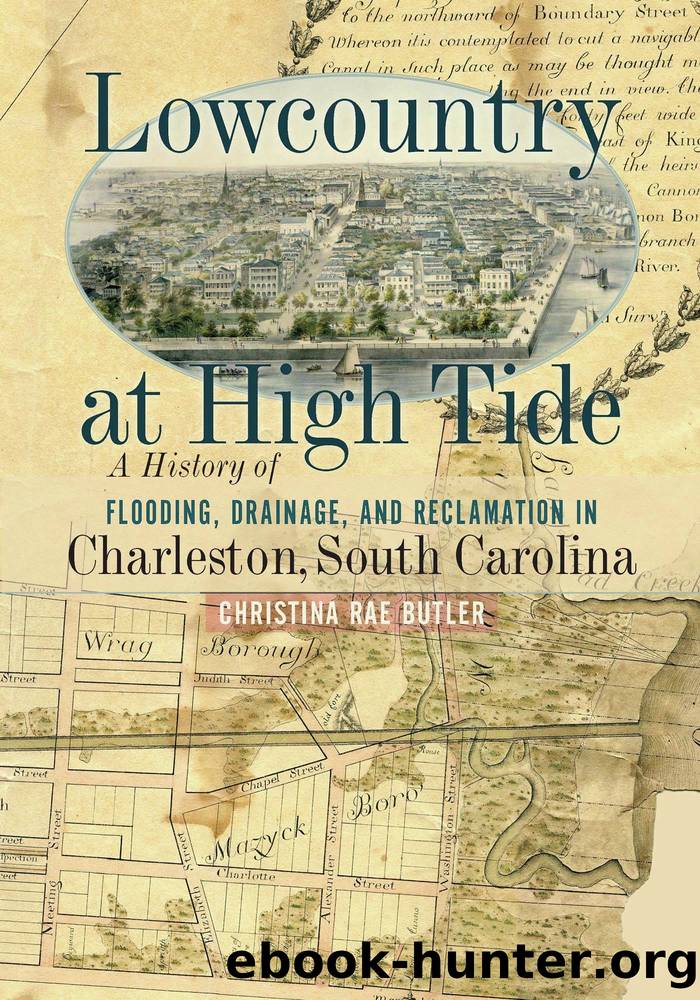Lowcountry at High Tide by Christina Rae Butler;

Author:Christina Rae Butler;
Language: eng
Format: epub
Publisher: University of South Carolina Press
Published: 2020-01-15T00:00:00+00:00
SIX
Between Two World Wars
The 1920s began as a decade of promise and economic optimism in Charleston. The navy base and satellite industries had expanded with World War I, and Charlestonâs population rose by 14.5 percent between 1919 and 1929, to seventy-one thousand residents, with nearly ten thousand people employed at the navy base and satellite industries prior to World War II.1 Grace guided the creation of a publicly owned Cooper River waterfront during his second term. In 1920 the General Assembly made a public port possible by passing an act, âRelating to the Power of Cities of Fifty Thousand Inhabitants or More to Condemn Lands on Water Front, So as to Give the Right to Condemn Property for Port Utilities,â which gave South Carolina municipalities the right to purchase, condemn, and possess land, wharves, docks, water, or rights-of-way for the âpurpose of establishing, improving, developing, maintaining, or operating the port and terminal facility of such city for public purposes.â2
Grace convinced the City Council to take a large financial risk in 1922 to purchase the Charleston Terminal Company for the considerable sum of $1.5 million.3 The City Council created the Ports Utilities Commission (PUC, later superseded by the State Ports Authority) to operate the wharves from Queen Street northward to Columbus Street and to alter the Cooper River waterfront as needed to expand the portâs facilities.4 The City Council used bonds to pay for the land and to expand and repair the port terminals, paving the way for waterfront growth and modernization for the rest of the twentieth century.5 After more than two centuries of private owners controlling and shaping the cityâs waterfront and the long-standing struggle between public interests and private ownership, the wharves became a civic responsibility through the creation of the new public port.
American cities were modernizing rapidly in the 1920s, and Charleston was adjusting to urban life that included automobiles, public works, and new conveniences.6 During the first year of Graceâs second term, investors began new real estate projects worth $3.9 million, four times the total private investment during Hydeâs last year as mayor.7 Grace increased drainage and paving spending, arguing the need to catch up from four years of infrastructural neglect under Hyde and to keep up with speculative development in the northwestern section of the city. The Riverside Development Company requested city permission to add infrastructure for Rose Garden tract and North Central subdivision in 1920, which sat atop the former site of Sans Souci, an eighteenth-century marsh-front plantation and that would require infilling. The plan proposed grading Sans Souci Street, adding water mains and sewerage hookups, and constructing drain lines for the new Peachtree, Maple, Cypress, and Darlington Streets, and upper Rutledge and Ashley Avenues. The City Council agreed to pay for the main drain trunks and paving as soon as Riverside Company had constructed $100,000 worth of dwellings.8
In 1921 the City Council purchased eight thousand cubic yards of cinder fill for $8,000 for the Murray Boulevard area. Alderman Daniel Lesesne Sinkler asserted that
Download
This site does not store any files on its server. We only index and link to content provided by other sites. Please contact the content providers to delete copyright contents if any and email us, we'll remove relevant links or contents immediately.
| Drafting & Mechanical Drawing | Fluid Dynamics |
| Fracture Mechanics | Hydraulics |
| Machinery | Robotics & Automation |
| Tribology | Welding |
Whiskies Galore by Ian Buxton(41938)
Introduction to Aircraft Design (Cambridge Aerospace Series) by John P. Fielding(33093)
Small Unmanned Fixed-wing Aircraft Design by Andrew J. Keane Andras Sobester James P. Scanlan & András Sóbester & James P. Scanlan(32764)
Craft Beer for the Homebrewer by Michael Agnew(18197)
Turbulence by E. J. Noyes(7978)
The Complete Stick Figure Physics Tutorials by Allen Sarah(7338)
Kaplan MCAT General Chemistry Review by Kaplan(6900)
The Thirst by Nesbo Jo(6879)
Bad Blood by John Carreyrou(6583)
Modelling of Convective Heat and Mass Transfer in Rotating Flows by Igor V. Shevchuk(6406)
Learning SQL by Alan Beaulieu(6237)
Weapons of Math Destruction by Cathy O'Neil(6215)
Man-made Catastrophes and Risk Information Concealment by Dmitry Chernov & Didier Sornette(5956)
Digital Minimalism by Cal Newport;(5704)
Life 3.0: Being Human in the Age of Artificial Intelligence by Tegmark Max(5516)
iGen by Jean M. Twenge(5385)
Secrets of Antigravity Propulsion: Tesla, UFOs, and Classified Aerospace Technology by Ph.D. Paul A. Laviolette(5333)
Design of Trajectory Optimization Approach for Space Maneuver Vehicle Skip Entry Problems by Runqi Chai & Al Savvaris & Antonios Tsourdos & Senchun Chai(5037)
Pale Blue Dot by Carl Sagan(4954)
